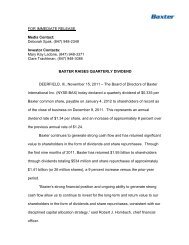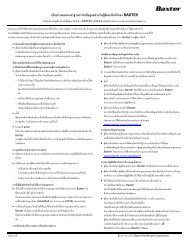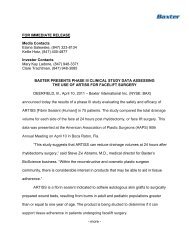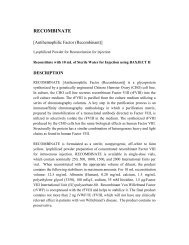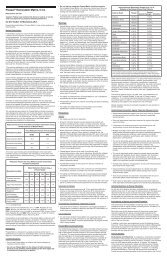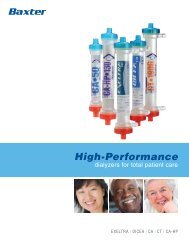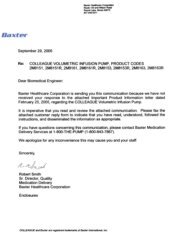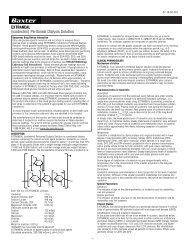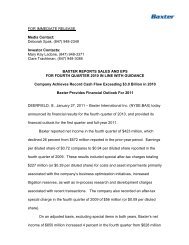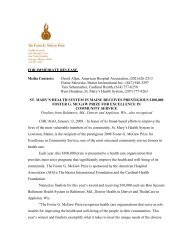COLLEAGUE Volumetric Infusion Pump Transition Guide - Baxter
COLLEAGUE Volumetric Infusion Pump Transition Guide - Baxter
COLLEAGUE Volumetric Infusion Pump Transition Guide - Baxter
You also want an ePaper? Increase the reach of your titles
YUMPU automatically turns print PDFs into web optimized ePapers that Google loves.
<strong>COLLEAGUE</strong> <strong>Volumetric</strong> <strong>Infusion</strong> <strong>Pump</strong><br />
<strong>Transition</strong> <strong>Guide</strong><br />
<strong>COLLEAGUE</strong> <strong>Volumetric</strong> <strong>Infusion</strong> <strong>Pump</strong>: <strong>Transition</strong> <strong>Guide</strong>
Table of Contents<br />
Customer Letter .......................................................................................................................... 1<br />
Step One: Review and Understand All Known Risks and Associated Mitigations<br />
Related to the Continued Use of <strong>COLLEAGUE</strong> <strong>Pump</strong>s ................................... 2<br />
Step Two: Complete the Certificate of Medical Necessity ................................................. 2<br />
Step Three: Review the Refund, Replacement, and Lease Termination Programs ........... 3<br />
A. Refund Program ................................................................................. 3<br />
B. Replacement Program ....................................................................... 4<br />
C. Termination of Leases…………………………………………………...5<br />
D. Additional Assistance……………………………………………………5<br />
E. Return of Your <strong>COLLEAGUE</strong> <strong>Pump</strong>s………………………………….6<br />
Step Four: Assess Alternative <strong>Infusion</strong> <strong>Pump</strong> Options ...................................................... 6<br />
A. Factors for Consideration ................................................................. 7<br />
B. Alternative <strong>Infusion</strong> <strong>Pump</strong> Options .................................................. 8<br />
Step Five: Select and Implement Your Preferred Option(s) ............................................ 10<br />
A. <strong>Infusion</strong> <strong>Pump</strong> <strong>Transition</strong> Procedure ............................................. 10<br />
Third Party Evaluation Resources .......................................................................................... 16<br />
<strong>Baxter</strong> <strong>Transition</strong> Support ........................................................................................................ 17<br />
Certificate of Medical Necessity (“CN”) Form and Instructions ........................... Appendix A<br />
Refund Calculation and Examples .......................................................................... Appendix B<br />
<strong>COLLEAGUE</strong> <strong>Volumetric</strong> <strong>Infusion</strong> <strong>Pump</strong>: <strong>Transition</strong> <strong>Guide</strong>
Dear <strong>COLLEAGUE</strong> <strong>Pump</strong> Customer:<br />
On July 13, 2010, the U.S. Food and Drug Administration (“FDA”) ordered <strong>Baxter</strong> Healthcare<br />
Corporation (“<strong>Baxter</strong>”) to recall <strong>COLLEAGUE</strong> <strong>Volumetric</strong> infusion pumps from the U.S. market.<br />
As part of our compliance with this order, <strong>Baxter</strong> is providing this <strong>Transition</strong> <strong>Guide</strong> (“<strong>Guide</strong>”) to<br />
facilitate your transition to a replacement device for your recalled <strong>COLLEAGUE</strong> pumps.<br />
You must review this <strong>Guide</strong> for important information about critical dates and action steps each<br />
facility must take, as well as key considerations regarding pump replacement or refund options.<br />
This <strong>Guide</strong> has been developed to serve four key purposes:<br />
• To ensure you are aware of key dates and actions that will:<br />
o Enable your facility to participate in the <strong>COLLEAGUE</strong> pump replacement or<br />
refund program. To participate in the pump replacement or refund program, you<br />
must submit a complete Certificate of Medical Necessity (“CN”) by November<br />
14, 2010. Instructions for completing and submitting the CN are provided in<br />
Appendix A of this <strong>Transition</strong> <strong>Guide</strong>.<br />
o Allow <strong>Baxter</strong> to continue service and support for this product during the transition<br />
period ending on July 14, 2012.<br />
• To ensure you are aware of all known risks and associated mitigations related to the<br />
continued use of <strong>COLLEAGUE</strong> pumps.<br />
• To provide information—including third-party resources—that will assist you in<br />
identifying, evaluating and selecting an alternative infusion pump, based on your facility’s<br />
needs and requirements.<br />
• To provide general guidance about preparing for the implementation of an alternative<br />
infusion system with minimal disruption to patient care.<br />
Your <strong>Baxter</strong> representative will be available to you to help answer any questions you may have<br />
relating to the <strong>COLLEAGUE</strong> pump and your transition to alternative devices. Additionally,<br />
<strong>Baxter</strong> has established a dedicated hotline at 1-800-422-9837 (Option 1) and a website with upto-date<br />
information regarding the <strong>COLLEAGUE</strong> pump transition. This can be accessed by<br />
linking to:<br />
www.baxter.com/information/safety_information/<strong>COLLEAGUE</strong>_information.html.<br />
Sincerely,<br />
David Bonderud<br />
President, U.S. Medication Delivery<br />
<strong>COLLEAGUE</strong> <strong>Volumetric</strong> <strong>Infusion</strong> <strong>Pump</strong>: <strong>Transition</strong> <strong>Guide</strong><br />
1
Introduction<br />
Customers must take five steps in order to transition to an alternative FDA cleared or<br />
approved product to replace the <strong>COLLEAGUE</strong> infusion pump and to be eligible for<br />
replacement or refunds:<br />
1. review and understand all known risks and associated mitigations related to the<br />
continued use of <strong>COLLEAGUE</strong> pumps;<br />
2. complete and return to <strong>Baxter</strong> a Certificate of Medical Necessity;<br />
3. review the refund and replacement programs established by <strong>Baxter</strong>;<br />
4. assess the available alternative infusion system options; and<br />
5. elect and implement your preferred option(s).<br />
By following those five steps, customers will be able to identify and efficiently implement<br />
the alternative infusion system that best suits their needs.<br />
Step One: Review and Understand All Known Risks and Associated<br />
Mitigations Related to the Continued Use of <strong>COLLEAGUE</strong><br />
<strong>Pump</strong>s<br />
Determine your facility’s medical necessity for the continued use of your <strong>COLLEAGUE</strong><br />
infusion pumps. As part of this determination, your facility should review the current<br />
known risks associated with the continued use of the <strong>COLLEAGUE</strong> infusion pumps,<br />
including all open recalls and known deficiencies. <strong>Baxter</strong> has made this safety<br />
information available to you at <strong>Baxter</strong>’s website:<br />
www.baxter.com/information/safety_information/<strong>COLLEAGUE</strong>.html#customer_letters.<br />
You should consider not using the <strong>COLLEAGUE</strong> pumps in situations where a<br />
replacement pump is not available or where a delay or interruption of therapy may be<br />
life threatening.<br />
Step Two: Complete the Certificate of Medical Necessity<br />
The next step in transitioning to an alternate product is to complete a Certificate of<br />
Medical Necessity (“CN”) form by November 14, 2010. Successful completion of a CN<br />
form accomplishes two goals:<br />
<strong>COLLEAGUE</strong> <strong>Volumetric</strong> <strong>Infusion</strong> <strong>Pump</strong>: <strong>Transition</strong> <strong>Guide</strong><br />
2
1. It allows your facility to receive ongoing support and service from <strong>Baxter</strong> for your<br />
<strong>COLLEAGUE</strong> pumps after November 14, 2010, and throughout the transition<br />
period, which ends on July 14, 2012.<br />
2. It enables your facility to be eligible for the replacement and/or refund options<br />
outlined within this <strong>Guide</strong>.<br />
A copy of the CN form and the instructions for properly completing the CN are included<br />
in Appendix A to this <strong>Guide</strong> as well as online at<br />
http://www.baxter.com/information/safety_information/<strong>COLLEAGUE</strong>_certificate.html.<br />
Step Three: Review the Refund, Replacement, and Lease Termination<br />
Programs<br />
<strong>Baxter</strong> has established refund, replacement, and lease termination programs to assist<br />
customers in their transition to an alternative infusion pump system. These programs<br />
are described below. <strong>Baxter</strong> will work with customers to determine which program (or<br />
combination of programs) is appropriate based on the customer’s clinical needs and<br />
preferences.<br />
Refund Program<br />
<strong>Baxter</strong> has established the <strong>COLLEAGUE</strong> refund program to afford funds to current<br />
owners of <strong>COLLEAGUE</strong> pumps to purchase any FDA cleared or approved replacement<br />
pump deemed appropriate for the owner’s particular needs. Under the refund program,<br />
<strong>Baxter</strong> will provide a refund to <strong>COLLEAGUE</strong> pump owners that is equal to the lesser of<br />
(a) the depreciated value of the device, or (b) the current owner’s documented purchase<br />
price.<br />
1. Depreciated value<br />
The depreciated value is based on a 10-year, straight-line, monthly depreciation<br />
of 90% of the purchase price from <strong>Baxter</strong>, beginning on the date the pump was<br />
sold by <strong>Baxter</strong> and ending on June 29, 2006. The depreciated value will be<br />
calculated according to the equation in Appendix B, subject to a minimum of<br />
$1,500 for a single channel <strong>COLLEAGUE</strong> pump or $3,000 for a triple channel<br />
<strong>COLLEAGUE</strong> pump.<br />
2. Documented purchase price<br />
In order to qualify for the refund, <strong>COLLEAGUE</strong> pump owners who did not<br />
purchase their pumps directly from <strong>Baxter</strong> or its agents must provide verifiable<br />
<strong>COLLEAGUE</strong> <strong>Volumetric</strong> <strong>Infusion</strong> <strong>Pump</strong>: <strong>Transition</strong> <strong>Guide</strong><br />
3
proof of purchase that shows the purchase price for the devices for which they<br />
are requesting a refund. <strong>Baxter</strong> will accept as verifiable proof of purchase written<br />
or electronic documentation that shows both proof of sale (i.e. bill of sale or<br />
purchase agreement) and proof of payment (i.e. wire transfer or cancelled<br />
check).<br />
The depreciated value calculation and examples of refund calculations are provided in<br />
Appendix B. Refunds under this program will be issued to customers within 10 days<br />
after receipt of the returned pumps. <strong>Baxter</strong> will cover the costs of shipping the returned<br />
<strong>COLLEAGUE</strong> pumps to <strong>Baxter</strong>. Further instructions regarding the return of<br />
<strong>COLLEAGUE</strong> pumps are provided in Step 3 (Return of Your <strong>COLLEAGUE</strong> <strong>Pump</strong>s) on<br />
page 6 of this <strong>Transition</strong> <strong>Guide</strong>.<br />
Replacement Program<br />
<strong>Baxter</strong> has established the <strong>COLLEAGUE</strong> replacement program for current pump<br />
owners that purchased their pumps directly from <strong>Baxter</strong>. The replacement program<br />
allows <strong>Baxter</strong> to offer those owners a SIGMA Spectrum infusion pump, including<br />
delivery, shipping, installation, and training, at no cost to the customer, to replace the<br />
recalled <strong>COLLEAGUE</strong> pump. The customer will return its <strong>COLLEAGUE</strong> pump to <strong>Baxter</strong><br />
after the customer has received, installed, and been trained by <strong>Baxter</strong> on the proper use<br />
and maintenance of the replacement SIGMA Spectrum pump. Further instructions<br />
regarding the return of <strong>COLLEAGUE</strong> pumps are provided in Step 3 (Return of Your<br />
<strong>COLLEAGUE</strong> <strong>Pump</strong>s) on page 6 of this <strong>Transition</strong> <strong>Guide</strong>.<br />
Under the replacement program, owners that purchased their pumps directly from<br />
<strong>Baxter</strong> may receive a SIGMA Spectrum infusion pump with a list price of $4,300 as a<br />
replacement for their single channel <strong>COLLEAGUE</strong> pump. <strong>Baxter</strong> will offer customers<br />
that own <strong>COLLEAGUE</strong> triple channel pumps one of the following options based on<br />
clinical need, existing channel usage, and Spectrum availability:<br />
1. Three (3) SIGMA Spectrum infusion pumps;<br />
2. Two (2) SIGMA Spectrum infusion pumps and one-third of the value (in cash) of<br />
the applicable refund for a triple channel <strong>COLLEAGUE</strong> pump;<br />
3. One (1) SIGMA Spectrum infusion pump and two-thirds of the value (in cash) of<br />
the applicable refund for a triple channel <strong>COLLEAGUE</strong> pump.<br />
<strong>COLLEAGUE</strong> <strong>Volumetric</strong> <strong>Infusion</strong> <strong>Pump</strong>: <strong>Transition</strong> <strong>Guide</strong><br />
4
<strong>Baxter</strong> anticipates offering Option #2 above as the standard option to triple channel<br />
pump owners. However, <strong>Baxter</strong> will make good faith efforts to honor its customers’<br />
preferences for replacement of triple channel <strong>COLLEAGUE</strong> pumps.<br />
Termination of Leases<br />
<strong>Baxter</strong> will permit pump lessees to terminate their leases without penalty. <strong>Baxter</strong> also<br />
will refund lessees for the unused portion of any <strong>COLLEAGUE</strong> infusion pump lease,<br />
within 10 days of receipt of the <strong>COLLEAGUE</strong> pump by <strong>Baxter</strong>.<br />
To terminate your <strong>COLLEAGUE</strong> pump lease, please contact your <strong>Baxter</strong> sales<br />
representative with the anticipated termination date. Your <strong>Baxter</strong> representative will<br />
make arrangements for the return (at <strong>Baxter</strong>’s expense) of your leased <strong>COLLEAGUE</strong><br />
pumps. A customer should not return <strong>COLLEAGUE</strong> pumps to <strong>Baxter</strong> until the customer<br />
has received and installed its replacement pumps.<br />
During the transition period (on or before July 14, 2012), some lessees may become<br />
owners of <strong>COLLEAGUE</strong> pumps through the exercise of contractual provisions that<br />
transfer title from <strong>Baxter</strong> to the lessee or otherwise grant the lessee the option to obtain<br />
title to the <strong>COLLEAGUE</strong> pumps. <strong>Baxter</strong> will honor such contractual provisions, thereby<br />
allowing those lessees that return a completed Certificate of Medical Necessity by<br />
November 14, 2010 to become eligible for the refund and replacement programs,<br />
described above. The applicable refund amount will depend on the specific details of<br />
the customer’s lease with <strong>Baxter</strong>. A lessee that will or that intends to take title to its<br />
<strong>COLLEAGUE</strong> pumps during the transition period should contact its <strong>Baxter</strong> sales<br />
representative for additional information on the refund and replacement programs.<br />
Additional Assistance<br />
Regardless of the option offered to the customer, <strong>Baxter</strong> also will provide the following<br />
assistance to customers:<br />
• <strong>Baxter</strong> will provide full refunds for the return of all unused <strong>COLLEAGUE</strong> pump<br />
spare parts, batteries, and consumables in unbroken packaging that are not past<br />
their shelf-lives. In addition to pumps, <strong>Baxter</strong> will also cover the costs of shipping<br />
the returned unused <strong>COLLEAGUE</strong> pump spare parts, batteries, and<br />
consumables to <strong>Baxter</strong>. Further instructions regarding the return of<br />
<strong>COLLEAGUE</strong> <strong>Volumetric</strong> <strong>Infusion</strong> <strong>Pump</strong>: <strong>Transition</strong> <strong>Guide</strong><br />
5
<strong>COLLEAGUE</strong> pumps (or parts) are provided in Step 3 (Return of Your<br />
<strong>COLLEAGUE</strong> pumps) on page 6 of this <strong>Transition</strong> <strong>Guide</strong>.<br />
• <strong>Baxter</strong> will refund all maintenance contract holders for the unused portion of any<br />
<strong>COLLEAGUE</strong> infusion pump service contract within 10 days after receipt of the<br />
pump by <strong>Baxter</strong>.<br />
• <strong>Baxter</strong> will not enforce any contract shortfall penalties arising from clinical<br />
practice changes necessitated by customers’ transition to an alternative drug<br />
infusion platform where <strong>Baxter</strong> products cannot be used by that platform;<br />
application by <strong>Baxter</strong> of a lower-discounted pricing tier based on a customer’s<br />
reduced purchase of <strong>Baxter</strong> products does not constitute a contract shortfall<br />
penalty.<br />
Return of Your <strong>COLLEAGUE</strong> <strong>Pump</strong>s<br />
Customers should contact their local <strong>Baxter</strong> representative to arrange for the cost-free<br />
return of their <strong>COLLEAGUE</strong> pumps and/or spare parts, batteries and consumables.<br />
<strong>Baxter</strong> will tailor the removal process based on the needs of the customer. For<br />
example, <strong>Baxter</strong> may provide prepaid shipping labels and packaging materials for the<br />
return of the pumps. Additionally, <strong>Baxter</strong> may provide on-site personnel to help facilitate<br />
the orderly removal of these pumps.<br />
The return process will include documentation of the serial numbers for the<br />
<strong>COLLEAGUE</strong> pumps to be returned, and reconciliation of those serial numbers against<br />
the list submitted with the customer’s completed Certificate of Medical Necessity. Once<br />
a completed Certificate of Medical Necessity is on file with <strong>Baxter</strong>, customers that are<br />
prepared to return their pumps should contact their <strong>Baxter</strong> representative to obtain the<br />
necessary information to execute the immediate return of their pumps.<br />
Note that customers should not return their <strong>COLLEAGUE</strong> pumps to <strong>Baxter</strong> until the<br />
customer has received and installed their replacement pump.<br />
Step Four: Assess Alternative <strong>Infusion</strong> <strong>Pump</strong> Options<br />
This section of the <strong>Transition</strong> <strong>Guide</strong> is intended to assist your facility’s decision-making<br />
process in identifying and assessing alternative infusion pump options. Below, <strong>Baxter</strong><br />
provides a representative sample of factors you should consider when replacing your<br />
fleet of <strong>COLLEAGUE</strong> pumps, potential alternatives to your <strong>COLLEAGUE</strong> pumps, and<br />
potential sources of additional information. There may be other factors and information<br />
<strong>COLLEAGUE</strong> <strong>Volumetric</strong> <strong>Infusion</strong> <strong>Pump</strong>: <strong>Transition</strong> <strong>Guide</strong><br />
6
that you may need to assess based on your facility’s specific policies and procedures<br />
for evaluating equipment.<br />
Factors for Consideration<br />
Fundamentally, your facility must assess your current and future infusion pump needs.<br />
Regardless of which <strong>COLLEAGUE</strong> alternatives your facility evaluates, the following<br />
steps should be considered in order to minimize disruption of patient care and reduce<br />
risk during the transition period:<br />
A. Determine your facility’s medical necessity for the continued use of your<br />
<strong>COLLEAGUE</strong> infusion pumps. As part of this determination, your facility should<br />
review the current known risks associated with the continued use of the<br />
<strong>COLLEAGUE</strong> infusion pumps, including all open recalls and known deficiencies.<br />
<strong>Baxter</strong> has made this safety information available to you at <strong>Baxter</strong>’s website,<br />
www.baxter.com/information/safety_information/<strong>COLLEAGUE</strong>.html#customer_letters.<br />
B. Determine your current and future utilization needs for infusion pump technology.<br />
<strong>Transition</strong>ing from a mix of single and triple channel devices to a single channel<br />
device will require determining the appropriate number of infusion devices to<br />
ensure the facility has enough devices to safely administer all IV medications.<br />
C. For each alternative technology or product, evaluate the following:<br />
1. The manufacturer’s Instructions for Use<br />
2. Reports of adverse events<br />
3. Product recalls<br />
4. Credible third party reports and published literature<br />
D. For each alternative technology or product, perform the following assessments,<br />
taking into account current and future requirements of your facility:<br />
1. Clinical assessment, involving input from a multidisciplinary team (i.e.<br />
physicians, nursing, pharmacy, anesthesia, materials management,<br />
biomedical engineering and Information Technology (IT) (if implementing a<br />
wireless technology)<br />
2. Financial assessment, including an assessment of costs of hardware,<br />
software, accessories, service and maintenance, etc.<br />
<strong>COLLEAGUE</strong> <strong>Volumetric</strong> <strong>Infusion</strong> <strong>Pump</strong>: <strong>Transition</strong> <strong>Guide</strong><br />
7
3. Technical assessment, including an assessment of the facility’s health<br />
information technology needs and capabilities, and how the pump meets<br />
those needs and capabilities (e.g. desired wireless capability and drug library<br />
capacity)<br />
Alternative <strong>Infusion</strong> <strong>Pump</strong> Options:<br />
Following is a discussion of suitable FDA approved or cleared alternatives to your<br />
facility’s <strong>COLLEAGUE</strong> infusion pumps. This discussion is intended as a broad overview<br />
to assist facilities in their independent decision-making, and not as a recommendation of<br />
any particular alternative pump technology or infusion pump. Note that the appropriate<br />
solution for your facility may include a combination of these alternatives.<br />
A. Non-Electronic Alternatives. Though non-electronic alternatives such as gravity<br />
flow, controlled gravity flow, or elastomeric/disposable pumps are clinically<br />
appropriate in certain situations, they generally are not clinically acceptable<br />
replacements to the controlled infusion of medications through an electronic<br />
pump. For example, administration of high alert intravenous medications can<br />
result in rapid physiologic changes and, therefore, must be precisely delivered.<br />
Such precise delivery typically cannot be achieved through a gravity infusion.<br />
Furthermore, certain safety features and accuracy capabilities that are standard<br />
in electronic infusion pumps are not available in non-electronic options.<br />
Elastomeric or disposable pumps generally are not clinically appropriate to<br />
support the infusion of life sustaining therapies, given those pumps’ lack of safety<br />
features such as controls or alarms. Accordingly, non-electronic alternatives<br />
likely will not be a clinically viable alternative to an electronic infusion pump in<br />
most clinical environments.<br />
B. Electronic <strong>Infusion</strong> <strong>Pump</strong> Alternatives: There are a number of electronic<br />
infusion pumps available for sale within the United States. These include<br />
alternative large volume infusion pumps, as well as other electronic clinical<br />
platforms such as syringe pumps. Please note that transitioning from a large<br />
volume infusion pump to an alternative platform such as a syringe pump may<br />
entail significant changes to pharmacy practice and clinical protocols and, as<br />
such, may not represent an appropriate or practical alternative to the<br />
<strong>COLLEAGUE</strong> pump.<br />
Electronic large volume infusion pumps typically are characterized by<br />
manufacturers and customers by the pump’s safety-related technological<br />
features. “Smart <strong>Pump</strong>s,” which are described in more detail in Step Five of this<br />
<strong>COLLEAGUE</strong> <strong>Volumetric</strong> <strong>Infusion</strong> <strong>Pump</strong>: <strong>Transition</strong> <strong>Guide</strong><br />
8
<strong>Transition</strong> <strong>Guide</strong>, contain advanced infusion pump technology that helps prevent<br />
the potential harm associated with errors in dose programming and calculations.<br />
Independent third parties such as the ECRI Institute (“ECRI”) recommend<br />
implementation of Smart pump technology and Smart <strong>Pump</strong>s now comprise the<br />
majority of the U.S. market share for electronic large volume infusion pumps.<br />
The FDA has developed a Total Product Life Cycle (TPLC)<br />
(www.fda.gov/aboutFDA/centersoffices/CDRH/CDRHtransparency/ucm199906.h<br />
tm), which contains a list of cleared infusion pump devices, their status, and<br />
Indications for Use (IFU) for each. In addition, the FDA TPLC website contains<br />
information on identified infusion pump issues, links to Medical Device Reports<br />
(MDRs), recalls and other information that may be of assistance in evaluating<br />
alternative options to your current <strong>COLLEAGUE</strong> pump. For information about<br />
accessing and searching the TPLC website, please refer to the “Third Party<br />
Evaluation Resources” section of this <strong>Transition</strong> <strong>Guide</strong> (page 16).<br />
Customers should carefully review available alternatives to understand and choose the<br />
right fit for their particular healthcare setting. Below is a non-exhaustive listing of large<br />
volume infusion pump manufacturers currently active in the U.S. market, and their<br />
representative large volume infusion Smartpump products. You can also find additional<br />
resources in the Third Party Evaluation section of this <strong>Guide</strong>, found on page 16, which<br />
contains references for third party organizations (e.g., ECRI and Institute for Safe<br />
Medication Practices (ISMP)) that provide additional independent resources for<br />
evaluating and choosing an appropriate alternative.<br />
Company Products Address and Website<br />
SIGMA<br />
(distributed by <strong>Baxter</strong>)<br />
SIGMA Spectrum 711 Park Avenue<br />
Medina, NY 14103<br />
Telephone: 888-229-0001<br />
www.SIGMApumps.com<br />
www.baxter.com<br />
B.Braun Space/Outlook 824 Twelfth Avenue<br />
Bethlehem, PA 18018<br />
Telephone: 800-227-2862<br />
www.bbraunusa.com<br />
Carefusion Alaris Medley 3750 Torrey View Court<br />
San Diego, CA 92130<br />
Telephone: 888-876-4287<br />
www.carefusion.com<br />
Hospira Plum A+<br />
Symbiq<br />
<strong>COLLEAGUE</strong> <strong>Volumetric</strong> <strong>Infusion</strong> <strong>Pump</strong>: <strong>Transition</strong> <strong>Guide</strong><br />
275 North Field Drive<br />
Lake Forest, IL 60045<br />
Telephone: 877-946-7747<br />
www.hospira.com<br />
9
Step Five: Select and Implement Your Preferred Option(s)<br />
This section of the <strong>Guide</strong> provides a general procedure for facilitating an orderly<br />
transition to an alternative infusion pump, whether through the <strong>COLLEAGUE</strong> refund or<br />
replacement program. It describes the transition to a Smart <strong>Pump</strong> (defined below), and<br />
covers assessment, implementation planning, execution, and post-install evaluation<br />
steps.<br />
Implementing a Smart <strong>Pump</strong> is a complex process requiring thorough planning to<br />
facilitate seamless integration into the facility’s clinical workflows. Well defined roles<br />
and responsibilities for all key stakeholders are critical to meeting pre-determined<br />
milestones and successfully achieving implementation goals.<br />
Furthermore, training relevant staff, and verifying and validating the alternative pumps,<br />
prior to use, are critical steps to ensuring the safe and effective use of the Smart <strong>Pump</strong>.<br />
Some facilities may seek the services of consultants to assist in the verification and<br />
validation of their alternative infusion pumps. Typically, pump manufacturers and<br />
vendors offer such consulting services in conjunction with the purchase of the infusion<br />
pump. To identify an independent consultant, facilities may contact the ECRI Institute<br />
and the Institute for Safe Medication Practices (ISMP); see the Third Party Evaluation<br />
Resource section of this <strong>Transition</strong> <strong>Guide</strong> for their contact information.<br />
<strong>Infusion</strong> <strong>Pump</strong> <strong>Transition</strong> Procedure<br />
I. Objective:<br />
To provide a consistent process for identifying and implementing an acceptable<br />
alternative to the <strong>COLLEAGUE</strong> <strong>Infusion</strong> pump.<br />
II. Scope:<br />
All <strong>COLLEAGUE</strong> <strong>Infusion</strong> <strong>Pump</strong>s within your facility.<br />
III. Exceptions:<br />
None<br />
IV. Definitions:<br />
1. Master Drug Library (MDL): A listing of all formulary IV medications with<br />
associated soft and hard limits and concentration parameters.<br />
2. Master Drug Library Administrator: Individual(s) responsible for the<br />
development and adoption of a facility’s Master Drug Library. Usually this<br />
role is assigned to a pharmacist.<br />
<strong>COLLEAGUE</strong> <strong>Volumetric</strong> <strong>Infusion</strong> <strong>Pump</strong>: <strong>Transition</strong> <strong>Guide</strong><br />
10
3. Qualified End User: Clinical personnel that have received validated<br />
product training from either the manufacturer or a trained “super user”.<br />
4. Smart <strong>Pump</strong>: Advanced infusion pump technology that helps intercept the<br />
potential harm associated with errors in dose programming and<br />
calculations. These systems incorporate Dose Error Reduction Software<br />
(DERS) that guides users toward safe practices and helps to reduce pump<br />
programming errors. The system relies on the development of a Master<br />
Drug Library which contains starting dose rates and concentrations for<br />
each customized drug inclusive of hard and soft limits and multiple dose<br />
modes.<br />
5. Smart <strong>Pump</strong> Administrator: Implementation team leader for the facility.<br />
6. Super User: Clinical staff that have received advanced training on the<br />
Smart <strong>Pump</strong>.<br />
<strong>COLLEAGUE</strong> <strong>Volumetric</strong> <strong>Infusion</strong> <strong>Pump</strong>: <strong>Transition</strong> <strong>Guide</strong><br />
11
V. <strong>Infusion</strong> System Implementation Checklist<br />
Step 1<br />
Review and Understand All Known<br />
Risks and Associated Mitigations<br />
Step 2<br />
Complete the Certificate of Medical<br />
Necessity<br />
Step 3<br />
Evaluate <strong>Infusion</strong> System Options<br />
Step 4<br />
Begin <strong>Transition</strong> Planning<br />
Step 5<br />
Step 6<br />
Initiate Implementation<br />
Validate the Implementation<br />
<strong>COLLEAGUE</strong> <strong>Volumetric</strong> <strong>Infusion</strong> <strong>Pump</strong>: <strong>Transition</strong> <strong>Guide</strong><br />
•Review all known risks associated with use of pumps<br />
•Determine your facility’s medical necessity for<br />
continued use of pumps<br />
• Verify and reconcile serial numbers of Colleague<br />
devices at your facility(‐ies)<br />
• Respond by deadline: November 14, 2010<br />
• Assemble multidisciplinary team to evaluate options<br />
• Develop comparison criteria (3 rd party<br />
references, Master Drug Library (MDL) size,<br />
wireless capability, standard safety features,<br />
testimonials)<br />
• Consult with Health Information System (HIS)<br />
vendor to address interface compatibility (if<br />
applicable)<br />
• Make a selection<br />
• Establish multi‐disciplinary implementation team<br />
implementation team<br />
• Develop Pharmacy/MDL and<br />
Information Technology/Integration plans<br />
• Establish training requirements<br />
• Validate wireless network<br />
• Validate MDL function<br />
• Conduct incoming pump inspections/acceptance<br />
testing<br />
• Download MDL to devices<br />
• Complete all staff training<br />
• Collect Colleague devices, catalog serial<br />
numbers for return and credit<br />
• Conduct unit‐to‐unit rounds<br />
• Conduct post‐implementation staff debrief<br />
• Assess compliance with training, MDL usage<br />
• Monitor device performance and report issues to the<br />
Manufacturer and/or FDA as appropriate<br />
12
VI. Detailed Procedure<br />
A. Assessment:<br />
1. Convene a multidisciplinary product evaluation committee to include all<br />
key stakeholders potentially affected by the purchase of a new pump<br />
2. Solicit comparative data on all considered alternatives to include:<br />
a. Relevant information regarding market clearance and<br />
Instructions for Use, as well as reports of device issues, adverse<br />
events, and recalls (See Third Party Evaluation Resource<br />
section)<br />
b. Technology roadmap for added functionality in the future (i.e.<br />
wireless capabilities, barcode reader, closed loop process<br />
control)<br />
c. Solicit third party references from current qualified end users<br />
d. Standard safety features<br />
e. Drug library size and user interface<br />
f. Ease-of-use (human factor) enhancements<br />
g. Current user testimonials<br />
h. Product literature<br />
i. Manufacturer’s Operating Manual<br />
j. Manufacturer’s Service Manual<br />
k. Develop a list of current disposables for cross referencing<br />
i. Consider drip rate factors<br />
ii. Breadth of disposable offering<br />
iii. Specialty product needs<br />
l. Complete a pump assessment to determine appropriate channel<br />
mix<br />
m. Complete a unit by unit practice review to ensure appropriate<br />
disposable offering<br />
3. Conduct an administration set review to facilitate a clinically<br />
appropriate reference<br />
4. Review facility policies and procedures to determine if any changes<br />
need to be initiated<br />
5. Conduct a clinical evaluation of alternative pumps to assess clinical<br />
acceptance<br />
a. Determine trial success criteria<br />
b. Determine trial units<br />
c. Determine trial schedule<br />
d. Educate trial unit end users<br />
<strong>COLLEAGUE</strong> <strong>Volumetric</strong> <strong>Infusion</strong> <strong>Pump</strong>: <strong>Transition</strong> <strong>Guide</strong><br />
13
e. Monitor trial evaluation forms<br />
f. Analyze trial data<br />
6. Conduct a financial impact assessment<br />
a. Hardware acquisition costs<br />
b. Software (SW) license fees<br />
c. MDL construction fees<br />
d. Accessories<br />
e. Service plans<br />
f. Maintenance fees<br />
g. Implementation charges<br />
h. Comparison of replacement and refund options including<br />
financial implications and Return on Investment (ROI)<br />
information<br />
B. Implementation Planning:<br />
1. Establish a multidisciplinary implementation team. Members should<br />
include, at a minimum, individuals from the following functions:<br />
physicians, nursing, pharmacy, anesthesia, materials management,<br />
biomedical engineering and Information Technology (IT) (if<br />
implementing a wireless technology)<br />
2. If Implementing a Smart <strong>Pump</strong><br />
a. Select a Smart <strong>Pump</strong> Administrator who will be responsible for<br />
leading the facility implementation process and be the key point<br />
of contact for interaction with the manufacturer team lead<br />
b. Determine an appropriate implementation timeline<br />
c. Appoint a Master Drug Library (MDL) Administrator<br />
d. Develop the facility MDL<br />
e. Develop the IT wireless installation plan<br />
3. Develop the End User Education Plan<br />
C. Execution<br />
1. Receive and perform safety inspections of all incoming pumps<br />
according to hospital policies and procedures<br />
2. Validate the alternative infusion pumps selected for use and<br />
compatibility with the hospital/facility wireless network, if applicable<br />
3. Download the MDL to all pumps<br />
4. Complete Super User training<br />
5. Initiate end user training utilizing unit rosters<br />
<strong>COLLEAGUE</strong> <strong>Volumetric</strong> <strong>Infusion</strong> <strong>Pump</strong>: <strong>Transition</strong> <strong>Guide</strong><br />
14
6. Swap current <strong>COLLEAGUE</strong> pumps with alternative infusion pumps<br />
following a predetermined schedule as communicated by the<br />
manufacturer’s representative<br />
7. <strong>Baxter</strong> will tailor the removal process based on the individual health<br />
care provider. (See Section “E” below)<br />
D. Post Install Evaluation<br />
1. Conduct unit to unit rounds to ensure qualified end users are<br />
comfortable with the new device<br />
2. Assess end user adoption of the MDL and compare to facility<br />
established goals<br />
3. Adjust MDL as necessary<br />
4. Conduct post implementation debrief meeting to answer additional<br />
questions<br />
E. Returning <strong>COLLEAGUE</strong> <strong>Pump</strong>s to <strong>Baxter</strong><br />
1. <strong>Baxter</strong> will tailor the return process based on the individual health care<br />
provider. A <strong>Baxter</strong> sales representative will provide details and arrange<br />
for the shipment of these pumps back to <strong>Baxter</strong> at no charge to the<br />
customer. This will include the documentation of serial numbers for all<br />
returned pumps. <strong>Baxter</strong> will cover the costs of shipping, packaging<br />
materials, or provide packing materials or return transport for the<br />
<strong>COLLEAGUE</strong> pumps. NOTE: Do not return your <strong>COLLEAGUE</strong> pumps<br />
until you have completed your transition to an alternative infusion<br />
device.<br />
<strong>COLLEAGUE</strong> <strong>Volumetric</strong> <strong>Infusion</strong> <strong>Pump</strong>: <strong>Transition</strong> <strong>Guide</strong><br />
15
Third Party Evaluation Resources<br />
There are a number of third-party organizations that provide reviews of available<br />
technology. One such organization is the ECRI Institute, which provides a<br />
comprehensive overview and evaluation of available infusion pump options within the<br />
United States. Another, the Institute of Safe Medication Practices (ISMP), has over 30<br />
years of experience leading the efforts to promote safe healthcare practices and<br />
improve medication use processes. ISMP has published guidelines for the safe<br />
implementation and use of Smart infusion pumps.<br />
Additionally, FDA recently added a dedicated ‘<strong>Infusion</strong> <strong>Pump</strong>s’ page to its Website that<br />
provides valuable information about infusion pumps. The FDA has also compiled<br />
information from multiple Agency databases relating to the total product lifecycle for<br />
devices.<br />
The ECRI and ISMP Website addresses are provided below, as are the instructions for<br />
accessing the FDA database:<br />
• The ECRI Institute<br />
5200 Butler Pike<br />
Plymouth Meeting, PA 19462-1298, USA<br />
Telephone: (610) 825-6000<br />
Fax: (610) 834-1275<br />
E-mail: info@ecri.org<br />
Web: www.ecri.org<br />
• Institute for Safe Medication Practices (ISMP)<br />
200 Lakeside Drive; Suite 200<br />
Horsham, PA 19044-2321<br />
Telephone: (215) 947-7797<br />
Fax: (215) 914-1492<br />
Web: www.ismp.org/default.asp<br />
For infusion pump specific implementation guidance see:<br />
Proceedings from the ISMP Summit on the Use of <strong>Infusion</strong> <strong>Pump</strong>s:<br />
<strong>Guide</strong>lines for Safe Implementation and Use<br />
www.ismp.org/Tools/guidelines/smartpumps/comments/printerversion.pdf<br />
• Access the U.S. Food and Drug Administration Website at www.fda.gov<br />
o For <strong>Infusion</strong> <strong>Pump</strong>s link to:<br />
www.fda.gov/medicaldevices/productsandmedicalprocedures/generalh<br />
ospitaldevicesandsupplies/infusionpumps/default.htm<br />
<strong>COLLEAGUE</strong> <strong>Volumetric</strong> <strong>Infusion</strong> <strong>Pump</strong>: <strong>Transition</strong> <strong>Guide</strong><br />
16
o Total Product Life Cycle (TPLC Reports) can be accessed by linking<br />
to:<br />
www.fda.gov/aboutFDA/centersoffices/CDRH/CDRHtransparency/ucm<br />
199906.htm<br />
� Upon reaching the TPLC homepage, Click on Database Search<br />
� Enter FRN in Product Code Section<br />
OR<br />
� Enter 880.5725 in Regulation Number Section, AND<br />
� Choose <strong>Infusion</strong> <strong>Pump</strong>s<br />
BAXTER TRANSITION SUPPORT<br />
For additional information regarding the transition, including additional copies of Certificate<br />
of Medical Necessity forms, please access:<br />
• www.baxter.com/information/safety_information/<strong>COLLEAGUE</strong>_information.html<br />
To speak with someone who can answer your questions, please either:<br />
• Call the <strong>COLLEAGUE</strong> Hotline at Center for One <strong>Baxter</strong>: 1-800-422-9837 (Option<br />
1)<br />
Days and Hours of Operation: 8AM-5PM Monday through Friday (You may leave<br />
a voice mail during non-business hours and your call will be returned the following<br />
business day); or<br />
• Contact your local <strong>Baxter</strong> representative<br />
• email questions to <strong>COLLEAGUE</strong>_transition@baxter.com.<br />
<strong>COLLEAGUE</strong> <strong>Volumetric</strong> <strong>Infusion</strong> <strong>Pump</strong>: <strong>Transition</strong> <strong>Guide</strong><br />
17
APPENDIX A: Certificate of Medical Necessity (“CN”) FORM and Instructions<br />
<strong>COLLEAGUE</strong> <strong>Volumetric</strong> <strong>Infusion</strong> <strong>Pump</strong>: <strong>Transition</strong> <strong>Guide</strong><br />
Appendix A
APPENDIX A: Certificate of Medical Necessity (“CN”) FORM and Instructions<br />
<strong>COLLEAGUE</strong> <strong>Volumetric</strong> <strong>Infusion</strong> <strong>Pump</strong>: <strong>Transition</strong> <strong>Guide</strong><br />
Appendix A
APPENDIX B: Refund Calculation and Examples<br />
<strong>COLLEAGUE</strong> <strong>Volumetric</strong> <strong>Infusion</strong> <strong>Pump</strong>: <strong>Transition</strong> <strong>Guide</strong><br />
Appendix B<br />
As described in Step 3 of this <strong>Transition</strong> <strong>Guide</strong>, <strong>Baxter</strong> will provide a refund to current<br />
<strong>COLLEAGUE</strong> owners that is the lesser of: (a) the depreciated value (see below), or (b)<br />
the owner’s documented purchase price.<br />
Following is the calculation by which the depreciated value of your <strong>COLLEAGUE</strong><br />
infusion pumps will be calculated.<br />
⎛ ( [Date Consent<br />
[Depreciat ed Value] = [Purchase Price] ∗ ⎜<br />
⎜0.<br />
9 −<br />
⎝<br />
Where:<br />
Example 1:<br />
Decree] -[Date<br />
Purchased] ) in Months ⎞<br />
⎟<br />
120 Months<br />
⎠<br />
[Purchase Price] = The price when the pump was last sold by <strong>Baxter</strong><br />
([Date of Consent Decree] – [Date Purchased]) = The positive value difference<br />
between the two dates<br />
expressed in months.<br />
The depreciated value is subject to a minimum of $1,500 for a single channel<br />
<strong>COLLEAGUE</strong> pump, or $3,000 for a triple channel <strong>COLLEAGUE</strong> pump.<br />
[Purchase Price] = $5,000<br />
[Date of Consent Decree] = June 29, 2006<br />
[Date Purchased] = June 1, 2005<br />
⎛ ( [June 2006] -[June<br />
2005] Months ⎞<br />
[Depreciat ed Value] = $5,000∗<br />
⎜<br />
⎜0.<br />
9 −<br />
⎟<br />
⎝<br />
120 Months ⎠<br />
⎛ 12 Months ⎞<br />
[Depreciat ed Value] = $5,000∗<br />
⎜<br />
⎜0.<br />
9 −<br />
⎟<br />
⎝ 120 Months ⎠<br />
[Depreciated Value] = $5000 X (0.9-0.1)<br />
[Depreciated Value] = $5000 X 0.8<br />
[Depreciated Value] = $4000
<strong>COLLEAGUE</strong> <strong>Volumetric</strong> <strong>Infusion</strong> <strong>Pump</strong>: <strong>Transition</strong> <strong>Guide</strong><br />
Appendix B<br />
The following additional examples reflect how the depreciated value and the refund for<br />
<strong>COLLEAGUE</strong> pumps will be calculated.<br />
Example 2:<br />
Hospital A purchased 10 <strong>COLLEAGUE</strong> triple channel pumps for $4000 per device in<br />
June 2002.<br />
[Purchase Price] = $4,000<br />
[Date of Consent Decree] = June 29, 2006<br />
[Date Purchased] = June 1, 2002<br />
[Depreciated Value] = $4000 X<br />
[Depreciated Value] = $4000 X<br />
Depreciated Value] = $4000 X (0.9 – 0.4)<br />
[Depreciated Value] = $4000 X 0.5<br />
[Depreciated Value] = $2000<br />
HOWEVER:<br />
0.9 -<br />
0.9 –<br />
[June 2006] – [June 2002] Months<br />
48Months<br />
120 Months<br />
120 Months<br />
[Minimum Depreciated Value] = $3000 per triple-channel device<br />
While the depreciated value of each of these 10 <strong>COLLEAGUE</strong> triple channel pumps is<br />
$2,000 based on the calculations, the minimum refund value for <strong>COLLEAGUE</strong> triple<br />
channel pumps purchased directly from <strong>Baxter</strong> is $3,000. Therefore, Hospital A will<br />
receive $3,000 per pump within 10 days of the return of each of these <strong>COLLEAGUE</strong><br />
triple channel pumps.
Example 3:<br />
<strong>COLLEAGUE</strong> <strong>Volumetric</strong> <strong>Infusion</strong> <strong>Pump</strong>: <strong>Transition</strong> <strong>Guide</strong><br />
Appendix B<br />
Hospital B owns 10 <strong>COLLEAGUE</strong> single channel infusion pumps purchased for $1300<br />
each in June 2000.<br />
[Purchase Price] = $1,300<br />
[Consent Decree Date] = June 29, 2006<br />
[Date Purchased] = June 1, 2000<br />
[Depreciated Value] = $1300 X<br />
[Depreciated Value] = $1300 X<br />
[Depreciated Value] = $1300 X (0.9 – 0.6)<br />
[Depreciated Value] = $1300 X 0.3<br />
[Depreciated Value] = $390<br />
HOWEVER:<br />
[Minimum Depreciated Value] = $1500 per single-channel device<br />
HOWEVER, in this case:<br />
0.9 -<br />
0.9 -<br />
[Minimum Depreciated Value] ≥ Actual Purchase Price<br />
[June 2006] – [June 2000] Months<br />
120 Months<br />
72 Months<br />
120 Months
<strong>COLLEAGUE</strong> <strong>Volumetric</strong> <strong>Infusion</strong> <strong>Pump</strong>: <strong>Transition</strong> <strong>Guide</strong><br />
Appendix B<br />
Therefore, while the minimum refund value for <strong>COLLEAGUE</strong> single channel pumps<br />
purchased directly from <strong>Baxter</strong> is $1,500, the refund is limited to the actual purchase<br />
price paid by the customer. In this particular example, Hospital B originally paid $1,300<br />
each for these 10 <strong>COLLEAGUE</strong> single channel pumps. Therefore, Hospital B will<br />
receive a refund of $1,300 for each of these particular pumps.<br />
Example 4:<br />
Hospital C bought 10 <strong>COLLEAGUE</strong> triple channel devices for $2,500 each and 20<br />
<strong>COLLEAGUE</strong> single channel devices for $1,000 each in a private transaction with<br />
Hospital D. Hospital C already had purchased 50 triple channel devices from <strong>Baxter</strong> in<br />
June 2002 for $5,000 apiece and 100 <strong>COLLEAGUE</strong> single channel devices purchased<br />
for $2,500 in June 2004.<br />
First, the value of the privately purchased units will be calculated as follows: Hospital C<br />
spent $45,000 in purchasing the additional <strong>COLLEAGUE</strong> devices (10 x $2,500 =<br />
$25,000, and 20 x $1,000 = $20,000). As a result, since Hospital C has documentation<br />
showing the actual purchase price and date from Hospital D and are eligible for full<br />
purchase price replacement value, or $45,000 since the full purchase price falls below<br />
the minimum refund value.<br />
Second, the value of the older devices purchased directly from <strong>Baxter</strong> would be<br />
calculated as follows:<br />
Triple channel devices, per unit<br />
[Purchase Price] = $5,000<br />
[Date Consent Decree] = June 29, 2006<br />
[Date Purchased] = June 1, 2002<br />
[Depreciated Value] = $5000 X<br />
[Depreciated Value] = $5000 X<br />
0.9 –<br />
0.9 –<br />
[June 2006] – June [2002] Months<br />
48 Months<br />
120 Months<br />
120 Months
[Depreciated Value] = $5000 X (0.9 – 0.4)<br />
[Depreciated Value] = $5000 X 0.5<br />
[Depreciated Value] = $2500<br />
HOWEVER:<br />
[Minimum Depreciated Value] = $3000 per triple-channel device<br />
<strong>COLLEAGUE</strong> <strong>Volumetric</strong> <strong>Infusion</strong> <strong>Pump</strong>: <strong>Transition</strong> <strong>Guide</strong><br />
Appendix B<br />
Therefore, since the depreciated value of the <strong>COLLEAGUE</strong> triple channel pumps is<br />
below the minimum value, Hospital C is entitled to $3,000 for each triple channel device,<br />
for a total of $150,000 for the 50 triple channel devices in its possession.<br />
Single channel devices, per unit<br />
[Purchase Price] = $2500<br />
[Date Consent Decree] = June 29, 2006<br />
[DatePurchased] = June 1, 2004<br />
[Depreciated Value] = $2500 X<br />
[Depreciated Value] = $2500 X<br />
[Depreciated Value] = $2500 X (0.9 – 0.2)<br />
[Depreciated Value] = $2500 X 0.7<br />
[Depreciated Value] = $1750<br />
0.9 –<br />
0.9 –<br />
[June 2006] – June [2004] Months<br />
24 Months<br />
120 Months<br />
120 Months
<strong>COLLEAGUE</strong> <strong>Volumetric</strong> <strong>Infusion</strong> <strong>Pump</strong>: <strong>Transition</strong> <strong>Guide</strong><br />
Appendix B<br />
Since the depreciated value of the <strong>COLLEAGUE</strong> single channel pumps is higher than<br />
the minimum value, Hospital C is entitled to $1,750 for each single channel device, for a<br />
total of $175,000 for the 100 single channel devices in its possession.<br />
Total refund calculation for Hospital C:<br />
Example 5:<br />
Units purchased from Hospital D: $ 45,000<br />
50 Triple Channel devices purchased<br />
from <strong>Baxter</strong> ($3,000 value) $ 150,000<br />
100 Single Channel devices purchased<br />
from <strong>Baxter</strong> ($1,750 per unit) $ 175,000<br />
Refund calculation TOTAL $ 370,000<br />
Upgraded to new <strong>COLLEAGUE</strong> pumps<br />
Beginning in June 2007, <strong>Baxter</strong> began deploying corrections to <strong>COLLEAGUE</strong> pumps<br />
pursuant to its approved Corrective Action Plan (CAP). As part of that deployment,<br />
rather than having their original single channel pump serviced, some customers instead<br />
opted to exchange their <strong>COLLEAGUE</strong> PUMPS for new <strong>COLLEAGUE</strong> pumps from<br />
<strong>Baxter</strong> at heavily discounted prices (an “upgrade payment”). As part of its refund<br />
program, <strong>Baxter</strong> will offer a refund of $1500 per device to those customers. This refund<br />
amount accounts for the depreciated value of the customer’s original <strong>COLLEAGUE</strong><br />
pump plus any upgrade payment. For example, a customer that traded in a pump with<br />
a depreciated value of $800 and made an upgrade payment of $500 in order to receive<br />
a new <strong>COLLEAGUE</strong> pump will receive the minimum refund of $1500 for this<br />
<strong>COLLEAGUE</strong> pump.<br />
<strong>Baxter</strong> and <strong>COLLEAGUE</strong> are registered trademarks of <strong>Baxter</strong> International Inc.<br />
Sigma and Sigma Spectrum are trademarks of Sigma International General Medical Apparatus, LLC.<br />
All other trademarks appearing herein are property of their respective owners.



